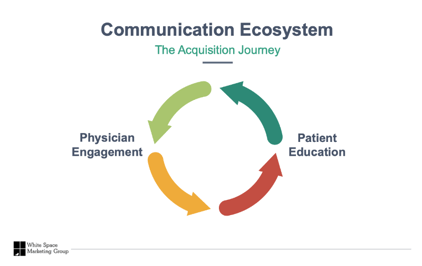
Separation of church and state is good in politics and publishing, but not in healthcare.
So often, healthcare organizations keep patient and professional engagement activity divided by a whale-sized moat. Most of the time, separate marketing teams run different patient and physician programs.
While it makes sense to approach subject matter distribution channels differently, this doesn’t mean the strategic thinking should be limited to a view from one audience’s perspective. The perspective, in fact, should be that of the brand.
Think about the communication ecosystem available to drive awareness and engagement:
- Marketing programs that drive patients to physicians for information, counsel, and care can be crafted in conjunction with those that educate physicians.
- Targeted campaigns that run simultaneously—and synergistically—have that good ol’ push-pull effect we want when building a brand and engaging multiple audiences.

Multipurpose Marketing
Let’s ask ourselves the following question: Where else is their healthy integration of different sub-groups within the healthcare industry? Best case scenario, you’re not only looking at communication integration strategies for the patient and physician audiences, you’re also considering how programs can be optimized in a “multipurpose” way to market (and educate) across specialties.
Think about the communication ecosystem of driving awareness and engagement.
For example, let’s take the rehabilitation field. One patient alone may encounter many types of healthcare providers during the course of acute or annual care.
If that patient learns about proactive physician therapy from multiple caregivers (i.e. her primary care physician, occupational therapist, orthopedist), the recommendation for an annual assessment will make more sense. On the flip side, if primary care physicians receive queries from a number of patients about proactive physical therapy, they’ll begin to consider recommending an annual assessment for more patients who exhibit early stage issues with their physiology.
Of course, this strategy doesn’t only apply to the healthcare industry. Any arena where the experience of both clients/customers and providers can be enhanced by this holistic approach is up for grabs (e.g. finance, law, retirement, education, hospitality, and even non-profits).
Market Expansion: What Drives Action?
It’s easy to think your different audience groups are unique and therefore should be marketed to in a siloed way.
Market expansion requires a more holistic view of what drives action.
And yes, a slice-and-dice approach is good when designing an implementation plan, so you can make sure you have the data from which to learn and optimize. But, market expansion requires a more holistic view of what drives action.








